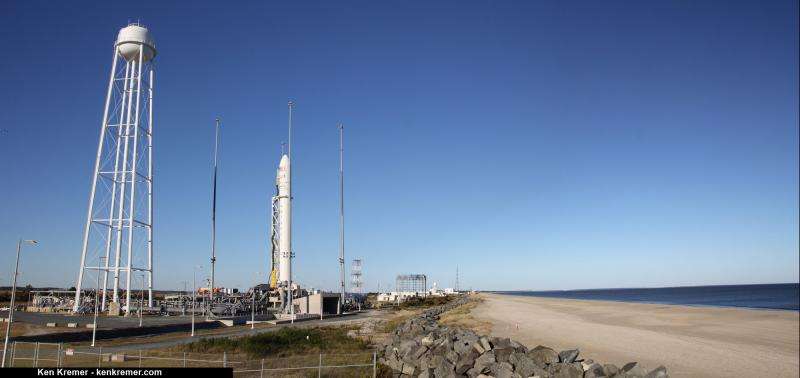NASA's space-station resupply missions to relaunch

NASA's commercial space program returns to flight this week as one of its private cargo haulers, Orbital ATK, is to launch its first supply shipment to the International Space Station in more than 13 months.
Orbital plans to launch its Cygnus capsule carrying more than 7,000 pounds of space-station equipment and supplies from Cape Canaveral, Fla., on Thursday evening.
Though the company has launched satellites from the Cape, this will be Orbital's first space-station resupply launch from there.
Orbital's first three resupply missions were launched from Wallops Island, Va. But seconds after the last launch, on Oct. 28, 2014, Orbital's rocket blew up, destroying it, a Cygnus and supplies.
This also will be the first launch attempt of any commercial resupply rocket to the space station since June, when a Falcon 9 used by NASA's other private space station cargo hauler, SpaceX, also blew up. SpaceX also plans to get back to launching this yearl, though it has not set a date.
Until now, Orbital was using its own Antares rockets. But they had old-design, Russian-made engines, and investigators determined that last year's failure was caused by one of them. So while Orbital reworks the Antares, the company has switched to using United Launch Alliance Atlas V rockets for this and the next mission. So those two rockets are going up from ULA's Cape Canaveral launch pad, which is specially-designed to handle Atlas V blast-offs.
The company hopes to use the Antares again by next spring, and that means a return to Wallops Island, where Orbital built a launch pad designed to handle those rockets.
"After the launch failure, our goal, and what we will achieve starting again in December, was to continue delivering cargo to the space station," said Frank DeMauro, Orbital's commercial resupply services program director and vice president of human space-flight systems.
"So we then went out and said, 'How do we do that?' The first thing we determined was that Antares was going to get a different engine. We also recognized that was going to take some time. And we wanted to get back to delivering cargo ahead of that," he said.
NASA is paying Orbital $1.9 billion for eight resupply missions and paying SpaceX $1.6 billion for 12 resupply missions. Since both companies have been grounded for the past few months, NASA had to turn to the Russians and Japanese to take supplies and equipment to the space station, which is orbiting Earth at an altitude of 230 miles with six astronauts aboard.
In a couple of years, NASA also will count on private contractors, SpaceX and Boeing, to ferry astronauts to and from the space station.
For NASA and the commercial space industry, there is more than just cargo riding on the Atlas V rocket, which has a perfect record of 60 successful launches.
"NASA is in a situation where it needs to have something work. If ULA fails, then questions will come regarding the feasibility of having the private sector supply the ISS, never mind taking crew to the ISS," said University of Central Florida professor Roger Handberg, an expert in space policy. "NASA is getting out of the Earth orbit business for the ISS, and has no viable option to return to that task if the private sector fails."
The Cygnus will need three days to reach the station. It will remain attached for up to 60 days, giving astronauts plenty of time to unload, and then reload it with garbage. The Cygnus and its trash will burn up when it re-enters the atmosphere in a couple of months.
This will also be the first mission for Orbital's reconfigured Cygnus capsule, which has room for 50 percent more cargo than before, and more than what SpaceX can carryr.
SpaceX determined that its Falcon 9 rocket exploded because a faulty strut broke inside the fuel tank, and that has been redesigned. In October the company announced it would be ready to launch again in a few weeks, and has plans for two Falcon 9 missions in December. However, its next space station resupply mission is not expected until early in 2016.
Meanwhile, NASA is preparing to award another round of space-station resupply contracts as soon as late January. Both Orbital and SpaceX are in the running, as is Sierra Nevada Corp., which proposes launching cargo inside its space plane-like Dream Chaser, and then flying it back to Kennedy Space Center like a space shuttle.
©2015 The Orlando Sentinel (Orlando, Fla.)
Distributed by Tribune Content Agency, LLC.



















